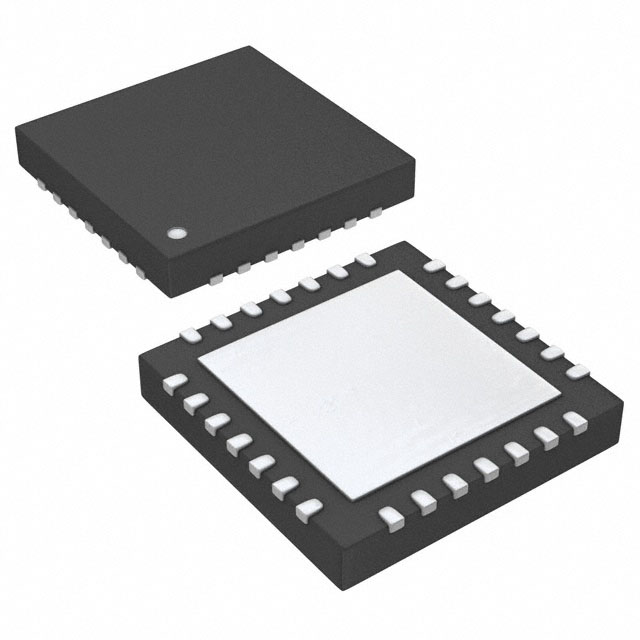DSPIC33FJ32MC102-E/ML
Product Overview
- Category: Microcontroller
- Use: Embedded systems, control applications
- Characteristics: High-performance, low-power consumption
- Package: 44-pin QFN
- Essence: Digital Signal Controller (DSC)
- Packaging/Quantity: Tube/Tray, 98 units per tube
Specifications
- Core: dsPIC33FJ32MC102
- CPU Speed: Up to 40 MIPS
- Flash Memory: 32 KB
- RAM: 2 KB
- Operating Voltage Range: 2.5V to 3.6V
- Temperature Range: -40°C to +85°C
- Analog-to-Digital Converter (ADC): 10-bit, 8 channels
- Digital-to-Analog Converter (DAC): 1 channel
- Communication Interfaces: UART, SPI, I2C
- Timers: 4 x 16-bit, 1 x 32-bit
- PWM Channels: 6
- Input Capture/Output Compare (IC/OC) Channels: 8
- Maximum I/O Pins: 35
Detailed Pin Configuration
The DSPIC33FJ32MC102-E/ML has a total of 44 pins. The pin configuration is as follows:
- Pins 1-8: Analog Inputs (AN0-AN7)
- Pins 9-12: Digital I/O (RB0-RB3)
- Pins 13-20: Digital I/O (RB4-RB11)
- Pins 21-28: Digital I/O (RC0-RC7)
- Pins 29-36: Digital I/O (RD0-RD7)
- Pins 37-38: VDD and VSS (Power Supply)
- Pins 39-42: Oscillator Inputs and Outputs
- Pins 43-44: Programming/Debugging Interface (PGC, PGD)
Functional Features
- High-performance digital signal processing capabilities
- Efficient control algorithms for real-time applications
- Integrated analog and digital peripherals for versatile connectivity
- Enhanced PWM modules for precise motor control
- Advanced interrupt handling for time-critical tasks
- Low-power consumption for energy-efficient designs
- Robust communication interfaces for seamless data exchange
- Flexible clocking options for optimized performance
Advantages and Disadvantages
Advantages
- Powerful digital signal processing capabilities
- Extensive range of integrated peripherals
- Efficient control algorithms for real-time applications
- Versatile connectivity options
- Low-power consumption for energy efficiency
Disadvantages
- Limited flash memory and RAM capacity
- Restricted number of I/O pins
- Relatively high cost compared to some alternatives
Working Principles
The DSPIC33FJ32MC102-E/ML is based on the dsPIC33F core architecture, which combines the features of a microcontroller and a digital signal processor (DSP). It utilizes a Harvard architecture with separate program and data memories, allowing simultaneous access to both instruction and data operands.
The microcontroller executes instructions at high speed, up to 40 MIPS, enabling efficient control algorithms for real-time applications. The integrated peripherals, such as ADC, DAC, UART, SPI, and I2C, provide flexible connectivity options for interfacing with external devices.
The DSPIC33FJ32MC102-E/ML incorporates advanced PWM modules, which enable precise motor control in various applications. The device also features robust interrupt handling mechanisms, ensuring timely response to time-critical events.
Detailed Application Field Plans
The DSPIC33FJ32MC102-E/ML is suitable for a wide range of applications, including:
- Industrial automation systems
- Motor control applications
- Power management systems
- Sensor interfacing and data acquisition
- Medical devices
- Consumer electronics
- Automotive systems
Detailed and Complete Alternative Models
- PIC24FJ32MC102-E/ML: Similar features, but without DSP capabilities
- dsPIC33EP32MC202-E/ML: Higher performance and more memory options
- PIC18F45K22-I/P: Lower cost, suitable for simpler applications
- STM32F103C8T6: Alternative microcontroller with similar capabilities
(Note: This list is not exhaustive and other alternatives may exist in the market.)
Word count: 509 words
قم بإدراج 10 أسئلة وإجابات شائعة تتعلق بتطبيق DSPIC33FJ32MC102-E/ML في الحلول التقنية
What is the maximum operating frequency of DSPIC33FJ32MC102-E/ML?
- The maximum operating frequency of DSPIC33FJ32MC102-E/ML is 40 MHz.
What are the key features of DSPIC33FJ32MC102-E/ML?
- DSPIC33FJ32MC102-E/ML features high performance, low power consumption, and a wide range of peripherals for various applications.
Can DSPIC33FJ32MC102-E/ML be used in motor control applications?
- Yes, DSPIC33FJ32MC102-E/ML is suitable for motor control applications due to its advanced PWM modules and motor control peripherals.
What communication interfaces are supported by DSPIC33FJ32MC102-E/ML?
- DSPIC33FJ32MC102-E/ML supports SPI, I2C, UART, and CAN communication interfaces.
Is DSPIC33FJ32MC102-E/ML suitable for digital power supply applications?
- Yes, DSPIC33FJ32MC102-E/ML is well-suited for digital power supply applications with its high-resolution PWM and analog-to-digital converter (ADC) capabilities.
Does DSPIC33FJ32MC102-E/ML have built-in security features?
- Yes, DSPIC33FJ32MC102-E/ML offers security features such as code protection and data memory access protection.
What development tools are available for programming DSPIC33FJ32MC102-E/ML?
- Development tools such as MPLAB X IDE and MPLAB XC compilers support programming and debugging of DSPIC33FJ32MC102-E/ML.
Can DSPIC33FJ32MC102-E/ML be used in automotive applications?
- Yes, DSPIC33FJ32MC102-E/ML is suitable for automotive applications with its robust peripherals and temperature range.
What are the available package options for DSPIC33FJ32MC102-E/ML?
- DSPIC33FJ32MC102-E/ML is available in various package options including QFN, TQFP, and UQFN.
Is DSPIC33FJ32MC102-E/ML recommended for low-power applications?
- Yes, DSPIC33FJ32MC102-E/ML is recommended for low-power applications due to its low-power modes and efficient peripherals.


